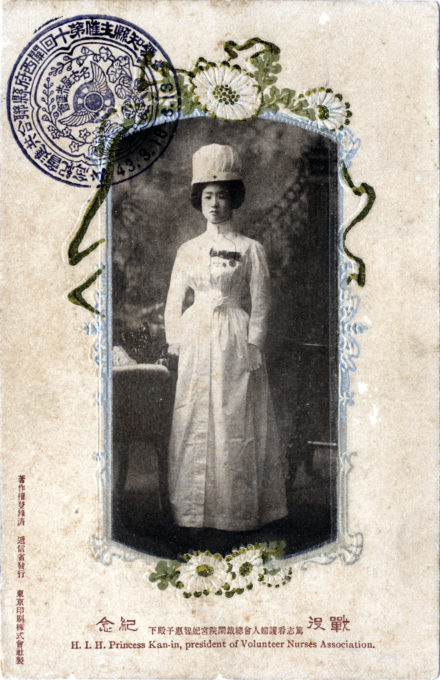
“H.I.H. Princess Kan-in, president of the Volunteer Nurses Association,” with a commemorative stamp dated 1910. The elite association was established in 1890 as an auxiliary of the Japan Red Cross which itself had been first established nationally in 1886.
See also:
Japan Red Cross Society commemorative postcard, c. 1937
Fifteenth Quadrennial International Red Cross Conference, Tokyo, 1934.
Ward in the Japanese Red Cross Central Hospital, Tokyo, c. 1910.
“Charity had been accepted as a legitimate arena for upper-class women since early in the Meij era; in wartime, this meant contributing to the care of the sick and wounded and providing for the survivors of those killed in battle. The empress herself provided a model for emulation: she visited military hospitals, rolled bandages, made donations to the Japan Red Cross, and bestowed presents on wounded soldiers and sailors.
“… Other women of the imperial family and women of peerage engaged in similar activities. The empress herself dispatched women from her household to visit the sick and wounded in hospitals throughout Japan [such as] Marchionesses Nabeshima and Oyama, often acting as representatives of the Ladies’ Volunteer Nursing Association of the Japan Red Cross … The crown princess and Princess Arisugawa sent to the military authorities boxes of bandages they had rolled themselves, and the Ladies’ Volunteer Nursing Association met regularly to roll bandages and hear lectures given by authorities on military medicine.
“… In fact, the activities of the Ladies’ Volunteer Nursing Association originated as a means of legitimating, by the example of upper-class women, military nursing as a feminine activity. The Japan Red Cross began formally training women as nurses in 1890. When the Sino-Japanese War broke out in 1894, they immediately dispatched twenty women to the military hospital at Hiroshima. By autumn 1904 they had provided over two thousand female nurses in the conflict with Russia, and in October the army began accepting nurses from other training schools as well. Press attention to upper-class women and the widows of officers created an impression that all women who became nurses did so because of self-sacrificing patriotism, a quality appropriate to women of all classes.”
– Recreating Japanese Women, 1600-1945, by Gail Lee Bernstein, 1991

“Japanese and foreign ladies of the Volunteer Nurses Association making bandages,” c. 1905. Over 130,000 of these cards were printed as part of a set of 3, titled “Red Cross Set” which included this postcard and the ones above and below.
“As a well-nigh million of young men left their homes to fight at the front, numerous families lost their main supporters and came to feel hard pressed in securing their livelihood. However, the sympathy of the rest of the nation for these bereaved families was deep and thoroughgoing, and the spirit of mutual assistance everywhere manifested itself in the formation of relief-associations.
“Everything was done to help the needy and relieve the distressed, by supplying work, giving shelter, patronizing trade, assisting in tillage, and taking care of infants, all according to the circumstances of the relieved, so that those serving at the front had no need of being anxious for their families at home. This is nothing but an excellent fruit of our national growth and refinement and at the same time a splendid manifestation of the spirit of humanity.”
– Relief Works During the War [between Russia and Japan] and Some Charitable Institutions, Ministry of Home Affairs, 1906


